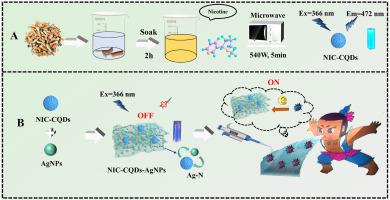一种基于废弃烟头的碳量子点和银纳米粒子的新型“开关”荧光探针,用于碘离子检测
IF 8.2
2区 材料科学
Q1 MATERIALS SCIENCE, MULTIDISCIPLINARY
引用次数: 0
摘要
被丢弃的烟头是一种经常被丢弃的废物,对环境构成严重威胁。因此,回收这些烟头对于减少环境污染和支持循环经济至关重要。本研究首次提出了一种利用废弃烟头生产尼古丁基碳量子点(NIC-CQDs)的新方法。这些NIC-CQDs与银纳米颗粒(AgNPs)结合,用于构建一种新型的“off-on”荧光探针,用于高灵敏度检测碘离子(I−)。实验结果表明,所制备的NIC-CQDs具有稳定、强烈的蓝色发光,最大发射波长(λem)为472 nm,最大激发波长(λex)为366 nm。通过内部过滤效应(IFE), AgNPs有效地猝灭了NIC-CQDs的荧光,而微量I−的存在逆转了这种猝灭现象。基于这一现象,设计了一种新型的开关荧光探针(NIC-CQDs-AgNPs),利用所得的NIC-CQDs和AgNPs检测水溶液中的痕量I -。在最佳条件下,NIC-CQDs-AgNPs探针的线性检测范围为0.1 ~ 90 μM (R2 = 0.993),检出限低至32 nM。该探针成功用于实际水样中I -的监测,回收率为94.28 ~ 104.28% (RSD < 4.81%),表明该荧光探针在环境水样中痕量I -的检测中具有巨大的应用潜力。本文章由计算机程序翻译,如有差异,请以英文原文为准。

A novel “off-on” fluorescence probe based on the discarded cigarette butts-based carbon quantum dots and silver nanoparticles for iodide ions detection
Discarded cigarette butts, a form of waste often left behind, pose a serious environmental threat. Therefore, recycling these cigarette butts is essential for reducing environmental pollution and supporting a circular economy. This study presents, for the first time, a novel approach to producing nicotine-based carbon quantum dots (NIC-CQDs) from discarded cigarette butts. These NIC-CQDs, combined with silver nanoparticles (AgNPs), were used to construct a novel “off-on” fluorescent probe for the highly sensitive detection of iodide ions (I−). Experimental results demonstrated that the obtained NIC-CQDs exhibited stable and intense blue luminescence, with a maximum emission wavelength (λem) of 472 nm and a maximum excitation wavelength (λex) of 366 nm. Through the inner filter effect (IFE), AgNPs effectively quench the fluorescence of NIC-CQDs, while the presence of trace amounts of I− reverses this quenching phenomenon. Based on this phenomenon, a novel off-on fluorescent probe (NIC-CQDs-AgNPs) was designed to detect trace I− in aqueous solution using the obtained NIC-CQDs and AgNPs. Under optimal conditions, the NIC-CQDs-AgNPs probe demonstrated a linear detection range for I− from 0.1 to 90 μM (R2 = 0.993) with a detection limit as low as 32 nM. The probe was successfully utilized for monitoring I− in real water samples with recoveries of 94.28–104.28 % (RSD <4.81 %), which indicated that the fluorescent probe has enormous application potential to detect trace I− in environmental water samples.
求助全文
通过发布文献求助,成功后即可免费获取论文全文。
去求助
来源期刊

Materials Today Nano
Multiple-
CiteScore
11.30
自引率
3.90%
发文量
130
审稿时长
31 days
期刊介绍:
Materials Today Nano is a multidisciplinary journal dedicated to nanoscience and nanotechnology. The journal aims to showcase the latest advances in nanoscience and provide a platform for discussing new concepts and applications. With rigorous peer review, rapid decisions, and high visibility, Materials Today Nano offers authors the opportunity to publish comprehensive articles, short communications, and reviews on a wide range of topics in nanoscience. The editors welcome comprehensive articles, short communications and reviews on topics including but not limited to:
Nanoscale synthesis and assembly
Nanoscale characterization
Nanoscale fabrication
Nanoelectronics and molecular electronics
Nanomedicine
Nanomechanics
Nanosensors
Nanophotonics
Nanocomposites
 求助内容:
求助内容: 应助结果提醒方式:
应助结果提醒方式:


